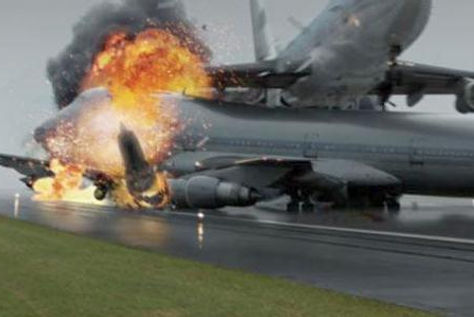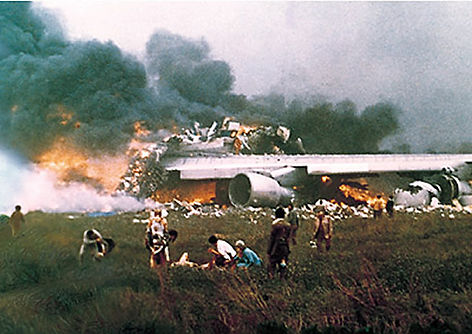

CRASH.

CRASH tells the stories of the 50 worst plane crashes in aviation history in terms of death toll. Below there are reviews, a chapter list and a chapter to check out.

Here is the chapter list for CRASH
I. Introduction
II. The First Air Crash Fatality
III. The 50 Worst Air Disasters
1.) 9/11: A Day That Changed the World
2.) The Tenerife Airport Disaster
3.) Japan Airlines Flight 123
4.) Mid-Air Crash Over India
5.) Turkish Airlines Flight 981
6.) Air India Flight 182
7.) Saudi Arabian Airlines Flight 163
8.) Iran Air Flight 655
9.) The Islamic Revolutionary Guard Crash
10.) The O’Hare Airport Crash
11.) Pan-Am Flight 103: Lockerbie
12.) Korean Air Flight 007
13.) American Airlines Flight 587
14.) China Airlines Flight 140
15.) Nationair Flight 2120
16.) Sightseeing Trip Turns Deadly
17.) Arrow Airways Flight MF1285R
18.) Malaysian Airlines Flight 370
19.) Garuda-Indonesia Airlines Flight 182
20.) Trans World Airlines Flight 800
21.) Swissair Flight 111
22.) Air France Flight 447
23.) Korean Airlines Flight 801
24.) The Air Africa Crash
25.) China Airlines Flight 611
26.) Lauda Air Flight 004
27.) Egypt Air Flight 990: A Criminal Event
28.) Air India Flight 855
29.) China Airlines Flight 676
30.) Aeroflot Flight 7425
31.) TAM Brazil Flight 3054
32.) Martinair Flight 138
33.) Birgenair Flight 301
34.) The Agadir Air Disaster
35.) LOT Polish Airlines Flight 5055
36.) Icelandic Airlines Flight 001
37.) Avianca Flight 11
38.) Inex Adria Flight 1308
39.) Aeroflot Flight 3352
40.) Mid-Air Crash Over Ukraine
41.) Surinam Airways Flight 764
42.) The Zagreb Mid-Air Collision
43.) The Kano Air Disaster
44.) Aeroflot Flight 217
45.) Union des Transportes Flight 772
46.) Cubana de Avacion Flight 9646
47.) Pulkovo Airlines Flight 612
48.) Kenya Airways Flight 431
49.) Caspian Airlines Flight 7908
50.) Pakistan Airlines Flight 268
Tenerife, Canary Islands 1977: Death toll 583: The Tenerife Airport Disaster involved two
aircraft. Pan American World Airways Flight 1736 was a Boeing 747 with 380 passengers on
board to go with a crew of 16. It was scheduled to fly from Los Angeles to the Canary Islands
with a stopover at JFK Airport in New York City. KLM Flight 4805 was flying out of Amsterdam
in the Netherlands with the same destination as the Pan-Am flight. Flight 4805 was also a
Boeing 747 and was carrying 234 passengers and a 14 member crew.
Neither plane was scheduled to land at Tenerife. The original schedule had both planes
landing at the Gran Canaria International Airport. However, a bomb had gone off at Gran
Canaria and there was still the possibility of more. As a result, all incoming flights were being diverted to the Los Rodeos Airport (now known as Tenerife Airport). Both flights 1736 and 4805 were among those diverted to Tenerife. The airport quickly became congested with air traffic controllers parking the planes wherever possible. In 1977, the Los Rodeos Airport was a smaller regional airport with just one runway. It had just one major taxiway with several smaller ones. When the airport became congested, the controllers began parking the planes on the biggest taxiways. With the taxiways unavailable, departing planes were forced to taxi along the runway prior to takeoff.
The Gran Canaria Airport finally reopened and Pan Am Flight 1736 was ready to go. However,
the KLM plane blocked its path to the runway. At the last minute the KLM crew requested
extra fuel. This was critical as it delayed the departures of both planes by close to 45 minutes. During this time a thick fog enveloped the airport. With the runway being blocked, departing
planes were forced to “back-taxi.” This meant that departing aircraft would taxi down the
runway before making a 180 degree turn and taking off in the opposite direction. Los Rodeos
had no ground tracking radar and the fog that had rolled in made it impossible for the air
traffic controllers to see what was going on. What was going on was that two giant 747’s
were on the same runway at the same time and nobody knew it.
While taxiing down the runway the Pan Am plane missed their turnoff. No one considered
this a problem. It was just a matter of continuing on to the next turnoff. It did however mean
that the Pan Am plane would be on the runway for a longer period of time. Meanwhile, the KLM crew was anxious to depart. They received route clearance from the tower but NOT flight
clearance. The first officer replied to the tower: “We are now at, uh, takeoff.” The captain said:
“We gone. Let’s go!” They had not yet received permission to takeoff. The Pan Am crew heard
the exchange and radioed that they were still taxiing down the runway. The air traffic
controllers heard this but apparently the KLM crew did not. The controller immediately told
the KLM flight to “standby for takeoff. I will call you.” They received no reply. The crew on the
Pan Am plane was getting edgy and worried as they listened to the transmissions. The cockpit recorder reveals that at this time Captain Victor Grubbs said: “Let’s get the fuck out of here.” Seconds later, Grubbs spotted the KLM plane through the fog and it was coming right at him.
Captain Grubbs cried out: “There he is. Look at him. God damn that son of a bitch is coming!” Grubbs did everything that he could to get out of harm’s way. He turned sharp left toward the
grass at the edge of the runway. Captain Veldhuyzen van Zanten on the KLM plane finally saw
the Pan Am plane directly in front of him. His only option now was to try and get up in time to clear the plane in front of him. It almost worked.
Two 747s crash in the world’s worst aviation accident
Just as it appeared that the KLM plane might be able to leapfrog the Pan Am plane,
its undercarriage ripped into the top of the Pan Am plane completely destroying the
mid section. The KLM plane then hit the runway and skidded for more than 1000 feet
while fire destroyed the aircraft and killed everyone on board. Almost unbelievably
there were 61 survivors on the Pan Am plane including all five members of the crew in
the cockpit at the time.
The investigation into the accident reached the conclusion that KLM Captain
Veldhuyzen van Zanten had attempted to takeoff without receiving the proper
clearance to do so. It was determined that the weather had also played an important
role. The fog that had enveloped the airport prevented the air traffic controllers from
seeing the two planes and also prevented the crews from seeing each other until it
was too late. Another factor was the extra fuel taken on by the KLM plane. It had
delayed the departure long enough for the fog to roll in. Another factor was the extra fuel taken
on by the KLM plane. It had delayed the departure long enough for the fog to roll in. The extra fuel also quite likely played a role in the plane not being able to clear the Pan Am plane in those last crucial seconds. The 583 dead makes the crash of the two 747’s the deadliest accident in aviation history.
